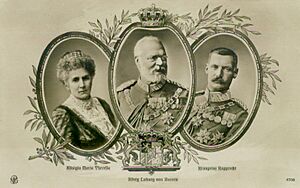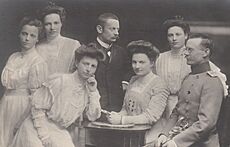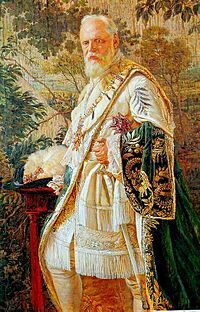Ludwig III of Bavaria facts for kids
Quick facts for kids Ludwig III |
|
|---|---|
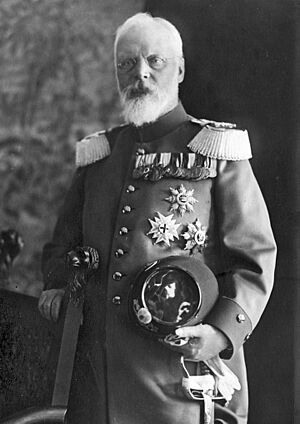
Ludwig III, c. 1910s
|
|
| King of Bavaria | |
| Reign | 5 November 1913 – 13 November 1918 |
| Predecessor | Otto |
| Successor | Monarchy abolished |
| Prime Ministers |
See list
Georg von Hertling
Otto von Dandl |
| Born | 7 January 1845 Munich, Kingdom of Bavaria, German Confederation |
| Died | 18 October 1921 (aged 76) Sárvár, Kingdom of Hungary |
| Burial | Munich Frauenkirche |
| Spouse | |
| Issue | Rupprecht, Crown Prince of Bavaria Adelgunde, Princess of Hohenzollern Princess Maria, Duchess of Calabria Prince Karl Prince Franz Mathilde, Princess Ludwig of Saxe-Coburg and Gotha Prince Wolfgang Princess Hildegarde Princess Notburga Wiltrud, Duchess of Urach Princess Helmtrud Princess Dietlinde Gundelinde, Countess of Preysing-Lichtenegg-Moos |
| House | Wittelsbach |
| Father | Luitpold, Prince Regent of Bavaria |
| Mother | Archduchess Auguste Ferdinande of Austria |
| Religion | Roman Catholic |
| Signature |  |
Ludwig III (born January 7, 1845 – died October 18, 1921) was the very last King of Bavaria. He ruled from 1913 to 1918. Before becoming king, he was a soldier in the Bavarian Army. He even fought in the Austro-Prussian War.
Ludwig was interested in politics from a young age. He became a member of the Bavarian parliament at 18. He supported changes to how people voted. Later, he was a regent, which means he ruled for his cousin, King Otto, who was unwell.
In 1913, a new law allowed Ludwig to become king himself. He led Bavaria during World War I. His time as king was short and focused on traditional ideas. After the war, the German Revolution of 1918–1919 changed everything. The German Empire was broken up, and the Weimar Republic was formed. The Bavarian throne was ended, and the House of Wittelsbach's 738-year rule was over. Ludwig left Bavaria for a while but returned in 1920. He died in 1921.
Contents
Early Life of Ludwig III
Ludwig was born in Munich. He was the oldest son of Luitpold, Prince Regent of Bavaria. His mother was Archduchess Auguste Ferdinande of Austria. She always spoke Italian to her children. Ludwig was named after his grandfather, King Ludwig I of Bavaria.
He spent his early years in royal palaces in Munich. From 1852 to 1863, he had a private teacher. When he was ten, his family moved to the Leuchtenberg Palace.
In 1861, at age 16, Ludwig joined the military. His uncle, King Maximilian II of Bavaria, made him a lieutenant. A year later, he went to the Ludwig Maximilian University of Munich. There, he studied law and economics. At 18, he automatically became a member of the Bavarian Legislature. This was because he was a prince of the royal family.
In 1866, Bavaria fought alongside the Austrian Empire in the Austro-Prussian War. Ludwig was a senior lieutenant. He was shot in the leg during the Battle of Helmstadt. This experience made him dislike military life. He received an award for his bravery.
Marriage and Family
In 1867, Ludwig went to a funeral in Vienna. There, he met Maria Theresia, who was 18. She was his step-cousin. They got married on February 20, 1868, in Vienna.
Ludwig was in line to become King of Greece. However, Maria Theresa's uncle was a very strict Catholic. He made Ludwig give up his claim to the Greek throne. This was to make sure their children would be raised Catholic. Also, the Greek constitution said their king could not rule another country. So, Ludwig's younger brother became the next in line for the Greek throne.
Maria Theresa inherited a lot of land and money from her father. She owned large estates in Hungary and what is now the Czech Republic. This money helped Ludwig buy an estate in Leutstetten, Bavaria. He made it a very successful farm. People sometimes called him Millibauer, which means "dairy farmer." This was because he loved farming.
Ludwig and Maria Theresa mostly lived at Leutstetten. They had a very happy marriage and 13 children:
- Rupprecht, Crown Prince of Bavaria (1869–1955)
- Princess Adelgunde of Bavaria (1870–1958)
- Maria Ludwiga, Princess of Bavaria (1872–1954)
- Karl, Prince of Bavaria (1874–1927)
- Franz, Prince of Bavaria (1875–1957)
- Princess Mathilde of Bavaria (1877–1906)
- Prince Wolfgang Maria Leopold of Bavaria (1879–1895)
- Princess Hildegard of Bavaria (1881–1948)
- Princess Notburga of Bavaria (1883–1883)
- Princess Wiltrud of Bavaria (1884–1975)
- Princess Helmtrud of Bavaria (1886–1977)
- Princess Dietlinde of Bavaria (1888–1889)
- Princess Gundelinde of Bavaria (1891–1983)
When her uncle Francis died in 1875, Maria Theresa became the Jacobite claimant to the thrones of England, Ireland, and Scotland. Some people called her Queen Mary IV and III.
Ludwig's Public Life
Ludwig was very interested in farming throughout his life. He was the leader of the Bavarian Agricultural Society. He also loved new technology, especially water power. He helped create the Bavarian Canal Society in 1891. In 1896, he became an honorary member of the Bavarian Academy of Sciences.
As a prince, he was part of the Bavarian legislature. He strongly supported giving people the right to vote directly. In 1870, he voted for Bavaria to join the North German Confederation. In 1871, he tried to become a member of the German parliament but did not win. In 1906, he supported changes to voting laws in Bavaria.
Becoming Regent of Bavaria
On December 12, 1912, Ludwig's father, Luitpold, passed away. Luitpold had been the regent for King Otto, who was not able to rule due to health issues. Ludwig immediately became the new regent.
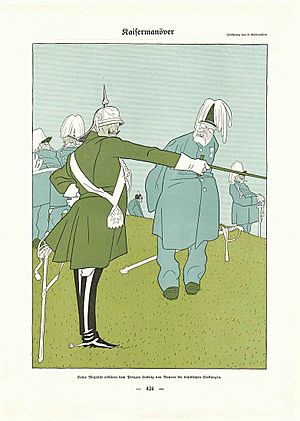
Soon, many people wanted Ludwig to become king. The Bavarian parliament met in September 1913. On November 4, 1913, they changed the Bavarian constitution. The new rule said that if a king had been unable to rule for ten years, the regent could become king. This had to be approved by the parliament.
The parliament voted for this change. The next day, November 5, 1913, Ludwig announced the end of his regency. He became King Ludwig III. The parliament agreed, and Ludwig took his oath on November 8.
Historians believe this change in 1913 was very important. It showed a step towards Bavaria becoming a modern constitutional monarchy. In this type of government, the king has less power.
Ludwig III as King
Ludwig's time as king was short and traditional. He was influenced by Catholic teachings. His Prime Minister, Georg von Hertling, stayed in office. Ludwig continued to live in the Wittelsbacher Palace, not the main royal residence.
When World War I started in 1914, Ludwig quickly showed Bavaria's support for Germany. He even wanted Bavaria to gain new lands, like parts of Alsace and the city of Antwerp. He hoped this would keep Bavaria strong within the German Empire.
There is a story that a young Austrian man, Adolf Hitler, asked Ludwig for permission to join the Bavarian Army. The story says Ludwig agreed. However, historians believe this account is not entirely accurate. It is more likely that Hitler joined the army through regular enlistment, like many others.
As World War I continued, Germany faced many problems. Ludwig became less popular. In 1917, his Prime Minister, Hertling, became the German Chancellor. A new Prime Minister, Otto Ritter von Dandl, took over in Bavaria.
Towards the end of the war, the German Revolution of 1918–1919 began in Bavaria. On November 7, 1918, Ludwig and his family fled from Munich. They went to a castle near Salzburg. He was the first German monarch to be removed from power. The next day, the People's State of Bavaria was declared.
On November 12, 1918, Prime Minister Dandl met with Ludwig. He hoped Ludwig would officially give up his throne. Ludwig did not use the word "abdicate." Instead, he signed a paper releasing all government workers and soldiers from their loyalty to him. He said he was "no longer in a position to lead the government."
The new government in Munich saw this as an abdication. They announced that Ludwig and his family could return to Bavaria as private citizens. This ended the 738-year rule of the House of Wittelsbach over Bavaria.
Final Years
Ludwig III returned to Bavaria. His wife, Maria Theresia, died in February 1919.
In February 1919, a political leader was killed. Fearing for his own safety, Ludwig fled Bavaria again. He went to Hungary, then Liechtenstein, and finally Switzerland. He came back to Bavaria in April 1920. He lived at Wildenwart Castle.
In September 1921, Ludwig traveled to his castle in Sárvár, Hungary. He died there on October 18, 1921.
On November 5, 1921, Ludwig's body was brought back to Munich. His wife's body was also brought back. They had a large state funeral. Many people attended, including the royal family, government officials, and about 100,000 spectators. They were buried in the crypt of the Munich Frauenkirche. This is where many of their royal ancestors are buried.
Images for kids
See also
 In Spanish: Luis III de Baviera para niños
In Spanish: Luis III de Baviera para niños



